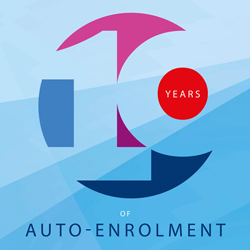10 years of Auto-enrolment: a race half run
Dale Critchley
Policy manager, workplace savings, Aviva

2012 was the year that the UK hosted the Olympic Games, the Queen celebrated her Diamond Jubilee, and Prime Minster David Cameron left his eight year old daughter at the pub. It was also the year that Automatic-Enrolment (AE) was introduced.
AE has, for the most-part, been a resounding success story. Driven on by a parliamentary consensus that saw the value of long-term pension planning, the Pensions Act was passed in 2008 – in the middle of a financial crisis. Four years later, the very first employees were automatically enrolled.
Over the past ten years there has been a transformation in terms of participation. Through the joint efforts of government, employers, employees, providers, trustees, advisers, and – who can forget – Workie, millions of workers have become retirement savers. And the pensions they are saving into have been transformed. Providers, advisers, administrators, trustees, and independent governance committees have worked together to drive down costs – to the point where the charge cap has become almost irrelevant – and to drive up service levels through the growth of digital propositions that were in their infancy a decade ago. However, AE has not yet crossed the finishing line. The next ten years are going to need just as much stamina to deliver the full potential of AE.
The biggest remaining challenge is adequacy. Too many savers are saving at a minimum rate that is too low to provide them with the retirement income they might be expecting. The focus on driving down charges comes at the expense of potential returns, and too few people are accessing advice and guidance services to make the most efficient use of their savings.
What needs to happen over the next ten years?
AE was a largely a success because of the long lead time. It gave government time to work on regulations and other stakeholders time to plan. There needs to be a similar plan for what AE will look like in in 2032. It should start with the abolition of the lower qualifying earnings threshold (LET), to level up contributions for lower-paid and part-time workers. AE should also be made accessible from 18 years old to give people more time to build up their pension pot. Ultimately, minimum contributions need to increase to a level that can deliver a living pension in retirement. By providing a clear roadmap, government will help provide the framework for stakeholders which helps to ensure better retirements.
Multiple stakeholders on the supply and demand side of the pensions industry will need to collaborate with legislators and regulators to refocus workplace pensions on outcomes and value, rather than the simple metric of charges. Pension providers on the supply side need to work with advisers to differentiate and add value, recognising that new solutions with potentially higher costs, will only attract clients if they offer demonstrably better value. At the same time, those on the demand side must become comfortable with uncertainty. Investment in private equity and debt, or in infrastructure, may guarantee a higher charge with only the promise of better returns. The challenge for advisers, their corporate clients and trustees is in recognising when that contract offers better value for members.
But all this will be for nought if people make the wrong decisions in retirement. Pension freedoms legislation, introduced in 2015, provide savers with a huge opportunity to create a flexible income stream that mirrors the transition into a new life stage, as opposed to a ‘cliff edge’ retirement. However, the rules also created the risk of tax advantages being wiped out, or income drying up in later life through ill informed decisions. We need to mitigate those risks.
The next ten years will see Defined Contribution (DC) pension pots far bigger than they are now, making up a larger percentage of pension income. Providers can mitigate some of the risks through packaged retirement income solutions, but to optimise outcomes individuals will need advice and guidance based on their personal circumstances. Individuals need to be persuaded of the value of advice. While the advice industry will need to evolve, enabled by regulation, to provide advice in a way that meets consumer needs and at a cost they are willing to pay.
The first ten years of automatic enrolment saw huge strides made turning workers into savers Looking ahead another ten years to 2032, the challenge for government and the industry is to find another gear and push on to make sure those savings turn into adequate incomes for what could be for some, marathon retirements.

